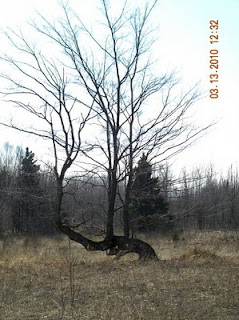We shall not cease from exploration,
And the end of all our exploring
Will be to arrive where we started
And know the place for the first time.
- T.S. Eliot
What began as a simple question posted on Facebook has somehow morphed
into a passionate search for answers, plenty of *OMG* moments, and the
beginning of a new quest.

"Does anyone know the true history of the "bent trees" on the way to Glen Cove?"
It was Coni Craig's simple question
that ultimately lead me to several research projects involved with the
identification of "Trail Trees" throughout the United States.
While most participating in these
projects presume that the Trail Trees were made and used by the Native
Americans, that doesn't seem to be the question that the skeptics raise.
Their question is more like "What makes you think they're man-made? We
think they're just a variant of nature."
So what does make the researchers think these trees were shaped by human beings rather than Mother Nature?
Intuition: Almost everyone involved in these
projects are people who came upon the trees in their wanderings in the
woods and thought they were very "different." They intuitively concluded
that they were man-made. A few of the researchers are serious "tree
watchers." They concluded the trees just don't "look natural."
Uniformity: All were surprised at how similar the examples are, despite being found in different locations.
Morphology: The trees have a number of characteristic
features that suggest man-made "wounds." The bumps, particularly the
ones that seem to be aligned, the characteristic "mouths" or "noses,"
and some have those striking horizontal indentations that look like
"tie-downs" were used to shape the trees.
Shape: The trees typically have a right angle bend in
the trunk [with no evidence of a break to explain it] - something just
not seen in other trees.
Density: The trees are often found in relatively close proximity with one another, in clumps in a few places, or in lines in others.
Proximity: The trees are all found in areas known to be
inhabited by earlier cultures of people. In the places where they've
been mapped like North Georgia, they seem to connect known settlements
or in Arkansas where they cluster in the Cherokee Lands.
Age: While the scientific dating of these trees has been spotty, they are usually quite old, much older than they look.
So how do the *bent trees* of Drummond Island figure into all of this?
One of my passions is preserving the rich historical tapestry of the
Upper Peninsula. Coni Craig shares that same passion. So together we set out to locate, map and submit the trees to the geographic
database to see if they do mark routes that are clear, and correlate
their distribution with earlier settlements.
What we found is that there IS a pattern - a logic - to their positions. That they most definitely are *Witness Trees*. But not necessarily Native American Witness Trees. Between 1944 and 1949 three separate planting of ruffled grouse were made on the Island by the Conservation Department. Given the age of the Bent Trees in this area we believe that some, if not all, of the Bent Trees of Glen Cove were made in an attempt by the Conservation Department to mark the original grouse grounds.
Regardless of their origin, the tress are still fascinating and following their trail makes for a great day long hike!
If, like me, you are interested in learning more about *Trail Trees*
and/or documenting the *Bent Trees* of Drummond Island - here are a few
resources to check out:
Go where there is no path and leave a trail.
~Ralph Waldo Emerson



































